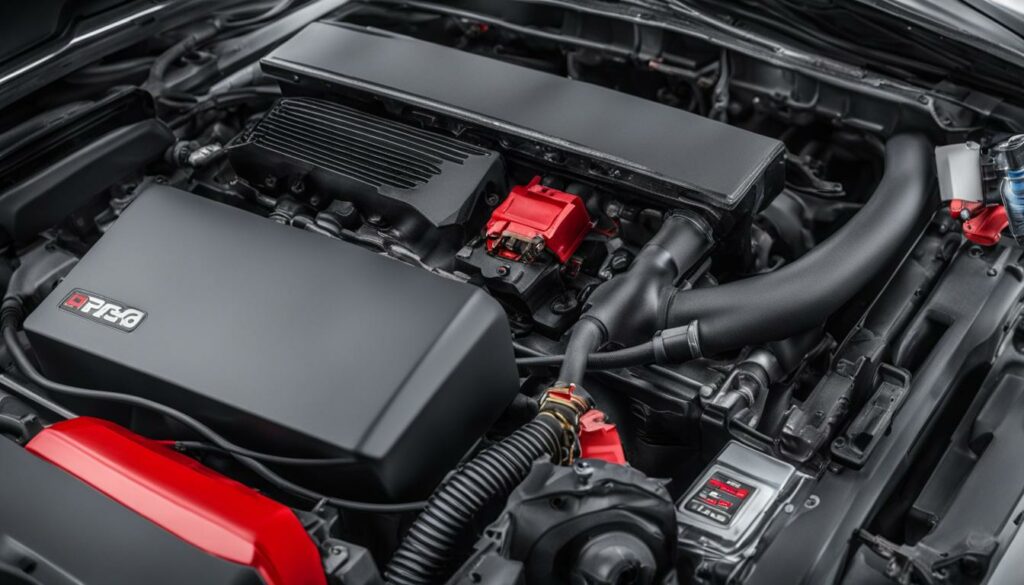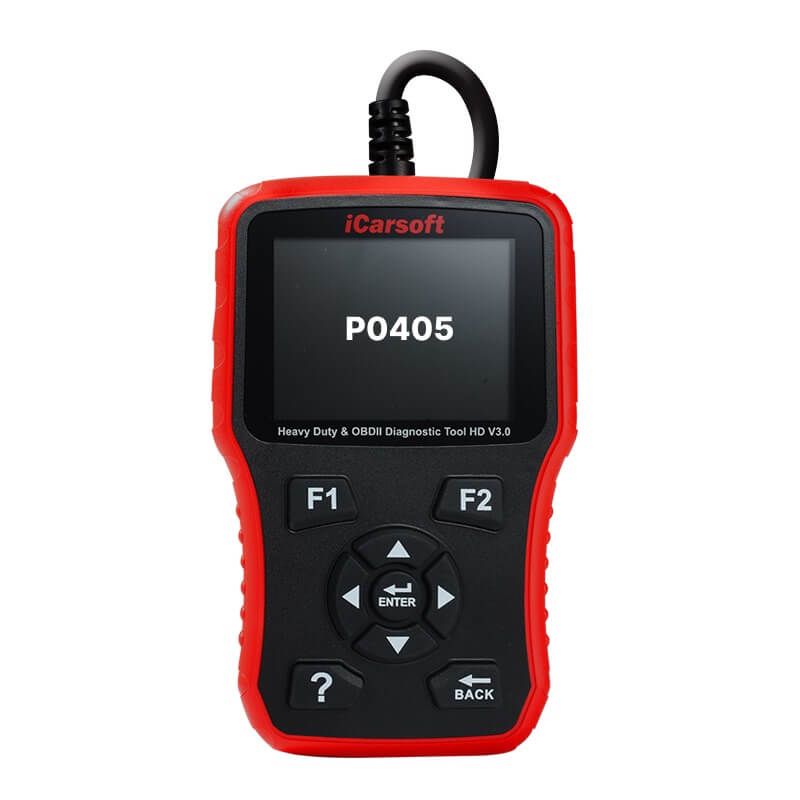P0405 – Exhaust Gas Recirculation Sensor A Circuit Low
POSTED IN pcodes
When it comes to the P0405 code, it is important to understand its technical description, meaning, severity, symptoms, common causes, troubleshooting steps, and repair options. This code is related to the engine’s exhaust gas recirculation (EGR) system and specifically, the EGR sensor. The EGR system plays a crucial role in maintaining acceptable levels of nitrogen oxide (NOx) emissions. The EGR sensor, also known as the EGR valve position sensor, monitors the position of the EGR valve and sends signals to the Powertrain Control Module (PCM).
If the PCM detects a lower than normal voltage level from the EGR sensor, it will trigger the P0405 code. This code signifies a low circuit voltage in the EGR sensor, indicating a malfunction in the EGR system that needs to be addressed promptly.
Encountering a P0405 code can lead to various symptoms, including an illuminated check engine light, failed emissions tests due to increased NOx emissions, decreased engine performance, engine pinging, poor fuel economy, and even engine stalling. These symptoms indicate a disruption in the EGR system’s operation, and it is crucial to investigate and resolve the issue to ensure proper engine performance and emissions control.
Diagnosing a P0405 code involves a systematic approach that includes using an OBD scan tool to retrieve the code, inspecting the EGR valve and sensor for physical damage or carbon buildup, checking the wiring and connections for any issues, and conducting tests to measure the voltage and resistance of the EGR sensor. These steps aid in identifying the cause of the code and subsequently guide the repair process.
Fixing a P0405 code typically involves replacing the faulty EGR valve position sensor or DPFE (Delta Pressure Feedback EGR) sensor, cleaning or replacing the EGR valve if necessary, repairing any circuit issues, and updating the PCM software if needed. Following proper repair procedures and using manufacturer-specific diagnostic tools is essential for a successful resolution.
Buy tested tuning file for Adblue / EGR / DPF / Adblue off now!
It’s important to note that troubleshooting and diagnosing issues with EGR sensors and the associated circuitry can be challenging due to the variations in EGR systems. A comprehensive understanding of the technical description and proper testing procedures for these sensors is crucial to ensure accurate diagnosis and effective repairs.
In conclusion, encountering a P0405 code indicates a malfunction in the EGR system and the associated sensor. Promptly addressing this issue is essential for maintaining proper engine performance and emissions control. If professional assistance is not available, there is the option of permanent removal of the code through reliable portals. Remember to consider the severity of the code, its symptoms, and the potential causes before making an informed decision for repair or alternative solutions.
Key Takeaways:
- The P0405 code relates to the exhaust gas recirculation (EGR) system and the EGR sensor.
- Symptoms of a P0405 code include an illuminated check engine light, increased NOx emissions, decreased engine performance, and poor fuel economy.
- Common causes of a P0405 code are a faulty EGR valve position sensor or DPFE, a bad EGR valve, circuit issues, or PCM-related problems.
- Diagnosing a P0405 code involves using an OBD scan tool, inspecting the EGR valve and sensor, checking wiring and connections, and conducting voltage and resistance tests.
- Fixing a P0405 code typically requires replacing faulty sensors, cleaning or replacing the EGR valve, repairing circuits, and updating PCM software.
Symptoms of P0405 Code
Experiencing the P0405 code indicates a malfunction in the Exhaust Gas Recirculation (EGR) system and its associated sensor. It is important to be aware of the symptoms related to this code to address the issue promptly and efficiently.
- Illuminated Check Engine Light: One of the primary indications of a P0405 code is the illumination of the check engine light on the dashboard. This serves as a warning sign of a potential problem with the EGR system.
- Failed Emission Test: Another noticeable symptom is a failed emission test. If your vehicle produces increased levels of nitrogen oxide (NOx) emissions, it may not meet the required standards, resulting in test failure.
- Decreased Engine Performance: A P0405 code can lead to decreased engine performance. You may experience reduced power, sluggish acceleration, or difficulty maintaining consistent speed.
- Engine Pinging: Pinging or knocking noises coming from the engine can also be an indication of an EGR system malfunction. This issue may occur due to improper combustion caused by excessive NOx emissions.
- Poor Fuel Economy: If you notice a significant drop in fuel efficiency, it could be linked to a P0405 code. The malfunctioning EGR system can disrupt the air-to-fuel ratio, resulting in increased fuel consumption.
- Engine Stalling: In some cases, a P0405 code can cause engine stalling, particularly during idle or low-speed situations. This can be a safety concern and should be addressed promptly.
To accurately diagnose and resolve the P0405 code, it is important to consider professional assistance or follow appropriate repair procedures. Understanding the symptoms associated with this code will help you take the necessary steps to restore your vehicle’s performance and maintain optimal emissions levels.
Causes of P0405 Code
If you have encountered the P0405 code, it is crucial to understand the common causes behind it. This code typically indicates a problem with the exhaust gas recirculation (EGR) system and its associated sensor. The following are the common causes of a P0405 code:
- A faulty EGR valve position sensor or Delta Pressure Feedback EGR (DPFE) sensor can trigger the P0405 code. These sensors play a crucial role in monitoring and controlling the EGR valve’s operation.
- A bad EGR valve can lead to the P0405 code. The valve might get stuck or fail to operate properly, causing disruption in the functioning of the EGR system.
- Circuit issues such as damaged wires or poor connections can also trigger the P0405 code. These issues can interfere with the accurate transmission of signals between the EGR sensor and the Powertrain Control Module (PCM).
- An issue with the PCM, such as outdated software, can also be a potential cause of the P0405 code. The PCM needs to receive accurate and reliable readings from the EGR sensor to ensure optimal engine performance.
Identifying and addressing these causes is essential in resolving the P0405 code and restoring the proper functionality of the EGR system.

Example Table:
| Cause | Description |
|---|---|
| Faulty EGR Valve Position Sensor or DPFE Sensor | The sensor responsible for monitoring the EGR valve’s position or measuring the pressure difference across the EGR system may be malfunctioning or providing inaccurate readings. |
| Bad EGR Valve | The EGR valve itself may be faulty, either getting stuck, failing to open or close properly, or experiencing internal mechanical issues. |
| Circuit Issues | Damaged wires or poor connections in the EGR system’s circuitry can disrupt the transmission of signals between the EGR sensor and the PCM. |
| Issue with PCM | Outdated software or other PCM-related problems can hinder the accurate interpretation of signals from the EGR sensor and lead to the P0405 code. |
Diagnosing a P0405 Code
Diagnosing a P0405 code can be a complex task due to the various EGR systems in different vehicles. However, there are essential steps you can follow to identify the cause and troubleshoot the issue effectively.
1. Retrieve the Code with an OBD Scan Tool
Using an OBD scan tool, retrieve the P0405 code from your vehicle’s Powertrain Control Module (PCM). This code indicates a low voltage level in the Exhaust Gas Recirculation (EGR) Sensor A Circuit.
2. Inspect the EGR Valve and Sensor
Visually inspect the EGR valve and sensor for any physical damage such as corrosion, carbon buildup, or loose connections. These issues can affect the proper functioning of the EGR system and trigger the P0405 code.
3. Check the Wiring and Connections
Examine the wiring harness connected to the EGR valve and sensor. Look for any signs of damage, frayed wires, or loose connections. Faulty wiring can lead to insufficient voltage or resistance readings, resulting in the P0405 code.
4. Measure the Voltage and Resistance of the EGR Sensor
Using a multimeter, measure the voltage and resistance of the EGR sensor. Compare the readings to the manufacturer’s specifications to determine if the sensor is functioning within the expected range. Deviations from the specified values may indicate a faulty sensor.
Did You Know? Carbon buildup on the EGR valve and sensor is a common cause of EGR system malfunctions. Regular maintenance and cleaning of these components can help prevent issues and prolong their lifespan.
By following these troubleshooting steps, you can narrow down the underlying cause of the P0405 code. Remember, if you’re unsure or prefer professional assistance, it’s always recommended to consult a qualified mechanic or technician.
Fixing a P0405 Code
When you encounter a P0405 code related to the Exhaust Gas Recirculation (EGR) system, it’s essential to take the necessary steps to fix the issue promptly. By addressing the problem, you can ensure optimal engine performance and prevent further complications. The following are the common repair procedures associated with P0405 code:
EGR Sensor Replacement
If your EGR valve position sensor or Delta Pressure Feedback EGR (DPFE) sensor is faulty and causing the P0405 code, replacement is crucial. These sensors play a vital role in the proper functioning of the EGR system. By using manufacturer-specific diagnostic tools, you can accurately identify the faulty sensor and replace it with a new one. This ensures accurate readings and prevents the code from reoccurring.
EGR Valve Cleaning or Replacement
In some cases, the EGR valve itself may be the source of the problem. Carbon buildup or physical damage can hinder the valve’s operation, resulting in a low circuit voltage and triggering the P0405 code. If inspection reveals excessive carbon buildup or damage, thorough cleaning or replacement of the EGR valve may be necessary. This helps restore the proper flow of exhaust gases and resolves the code issue.
Circuit Issue Repair
In addition to the sensors and the valve, circuit issues can also contribute to the P0405 code. Damaged wires, poor connections, or other electrical faults can disrupt the EGR system’s performance, leading to the code’s activation. It is essential to inspect the wiring harness and connections for any signs of damage or loose connections. Repairing these circuit issues ensures proper signal transmission and eliminates the code.
PCM Software Update
In some instances, outdated software in the Powertrain Control Module (PCM) can also trigger the P0405 code. To resolve this, updating the PCM software to the latest version may be necessary. This can be done by using specialized diagnostic tools or seeking assistance from a professional technician who has access to the latest software updates. Updating the PCM ensures optimal compatibility and resolves any software-related issues contributing to the code.
By following these repair procedures, you can effectively fix the P0405 code and restore your vehicle’s EGR system to proper functioning. Remember to use manufacturer-specific diagnostic tools and adhere to proper repair procedures to ensure a successful fix.

| Steps to Fix a P0405 Code | Key Takeaways |
|---|---|
| 1. Replace the faulty EGR valve position sensor or DPFE sensor | • Use manufacturer-specific diagnostic tools for accurate identification • Ensure proper installation of the new sensor |
| 2. Clean or replace the EGR valve if necessary | • Address carbon buildup or physical damage • Ensure proper flow of exhaust gases |
| 3. Repair any circuit issues | • Inspect and address damaged wires or poor connections • Restore proper signal transmission |
| 4. Update the PCM software if needed | • Seek assistance from professional technicians if required • Ensure compatibility and resolve software-related issues |
EGR Sensors and DPFE
EGR sensors are vital components of the EGR system, specifically the EGR valve position sensor and Delta Pressure Feedback EGR (DPFE) sensor. These sensors play a crucial role in ensuring the smooth operation of the EGR system and maintaining optimal engine performance.
The EGR valve position sensor is responsible for detecting the position of the EGR valve, which allows the Powertrain Control Module (PCM) to regulate the flow of exhaust gas into the intake manifold. This feedback helps optimize combustion efficiency and reduce emissions.
The DPFE sensor, on the other hand, measures the pressure difference across the EGR system. It provides valuable information to the PCM, allowing it to accurately control the EGR valve’s operation and ensure proper emission control.
When troubleshooting EGR system issues, understanding the technical description of these sensors is crucial. Proper testing procedures should be followed to diagnose any potential faults accurately.
| EGR Sensor | Function |
|---|---|
| EGR Valve Position Sensor | Detects the position of the EGR valve, providing feedback to the PCM for precise control of exhaust gas recirculation. |
| DPFE Sensor | Measures the pressure difference across the EGR system, allowing the PCM to adjust the EGR valve’s operation for optimal emission control. |
Conclusion
In conclusion, if you encounter a P0405 code, it is a clear indication of a problem with the Exhaust Gas Recirculation (EGR) system and its associated sensor. It is crucial to address this issue promptly to ensure optimal engine performance and emissions control.
If professional assistance is not readily available, there is another option to consider – the permanent removal of the P0405 code. This can be achieved by uploading the Engine Control Unit (ECU) file to a reliable online portal. However, before opting for this solution, it is important to understand the severity of the code, its symptoms, and the potential causes. Making an informed decision regarding repair or alternative solutions is essential.
Remember, while permanent removal may provide temporary relief, it is advisable to seek the expertise of a professional technician who can accurately diagnose the issue and implement the appropriate repairs. They possess the knowledge, experience, and specialized tools to rectify EGR sensor failure effectively and ensure the long-term reliability of your vehicle.
FAQ
What is the P0405 code related to?
The P0405 code is related to the engine’s exhaust gas recirculation (EGR) system and the corresponding sensor.
What is the role of the EGR system?
The EGR system is responsible for maintaining acceptable levels of nitrogen oxide (NOx) emissions.
What does the EGR sensor do?
The EGR sensor monitors the EGR valve and sends signals to the Powertrain Control Module (PCM).
What triggers the P0405 code?
The P0405 code is triggered when the PCM detects a lower than normal voltage level from the EGR sensor.
What are the symptoms of a P0405 code?
The symptoms may include an illuminated check engine light, failed emission test, decreased engine performance, engine pinging, poor fuel economy, and engine stalling.
What are the common causes of a P0405 code?
The common causes are a faulty EGR valve position sensor or DPFE, a bad EGR valve, circuit issues, and an issue with the PCM.
How is a P0405 code diagnosed?
Diagnosing a P0405 code involves using an OBD scan tool, inspecting the EGR valve and sensor, checking the wiring and connections, and conducting tests to measure the voltage and resistance of the EGR sensor.
What is the process for fixing a P0405 code?
Fixing a P0405 code involves replacing the faulty EGR valve position sensor or DPFE, cleaning or replacing the EGR valve, repairing any circuit issues, and updating the PCM software if needed.
What is the role of EGR sensors like the EGR valve position sensor and DPFE sensor?
EGR sensors provide valuable information to the PCM for controlling the EGR valve operation and monitoring emissions.
What is the importance of addressing a P0405 code promptly?
Addressing a P0405 code promptly is crucial to maintain proper engine performance and emissions.
Is permanent removal of the P0405 code an option?
If professional assistance is not available, consider the option of permanent removal of the Pcode by uploading the Engine Control Unit (ECU) file to a reliable portal.


